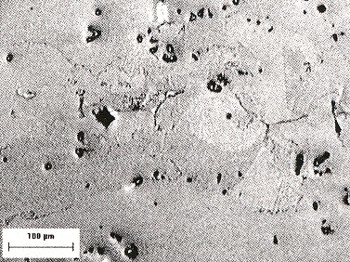Transient liquid phase bonding, also known as diffusion brazing, is a metal joining process that produces a high-quality bond through the isothermal solidification of a melting point depressant-rich interlayer. The advantage of using diffusion brazing over conventional processes is that the microstructural properties in the fusion zone are very similar to those of the base metal. The process is broken down into four distinct stages; heating, dissolution, isothermal solidification, and homogenization. The rate-controlling stage of the process is the isothermal solidification stage which may take hours or even days.

Recently, VAC AERO teamed up with researchers from the Mechanical Engineering Department of the University of Waterloo (Waterloo, Ontario) to develop a practical method for diffusion brazing of Inconel 738. This alloy is used extensively in turbine engine hot section components. Brazing techniques are often used to restore these components when they have been damaged in service, but conventional vacuum brazing produces a repair with limited durability.
The VAC AERO study involved an analysis of how bonding time, temperature and pressure affect the stress-rupture properties of the diffusion brazed joint. The objective was to minimize the bonding time by varying other parameters to yield a commercially viable repair technique. Differential scanning calorimetry was used to understand the isothermal kinetics of the melting and solidification of the interlayer. Test coupons were then prepared and brazed under a variety of conditions. The coupons were sectioned and examined using optical and scanning electron microscopy. Stress-rupture specimens were then brazed using parameters that produced the most promising visual results.
The outcome of this study proved it was possible to create diffusion brazed joints in IN738 with stress-rupture properties averaging 92.5% of the base metal properties, a remarkable result. Furthermore, this could be accomplished in a reasonable period of time. VAC AERO now plans to implement the results of this study in practical repair applications.
